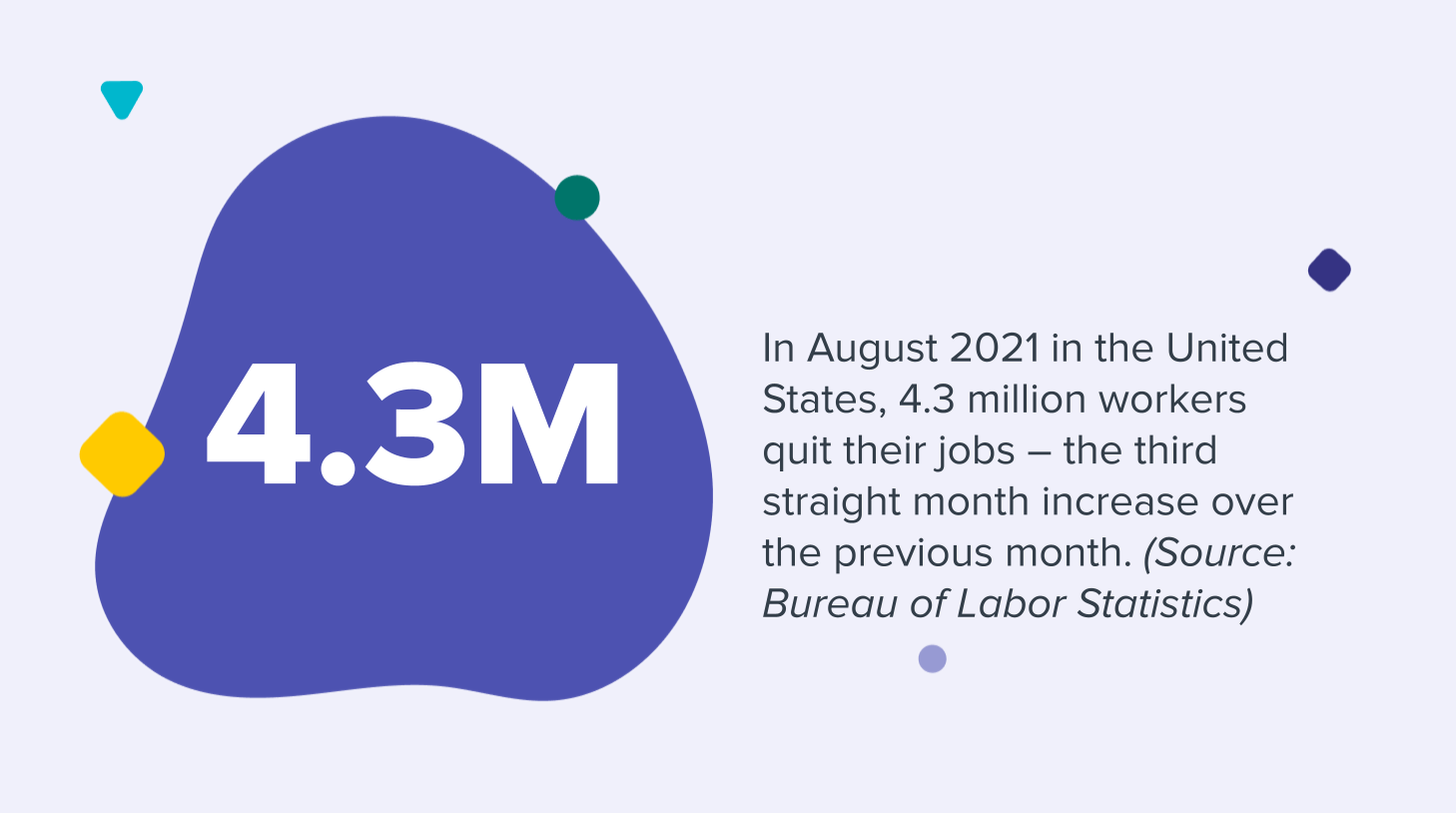3 workforce trends to prepare for in the last quarter of 2021
The last quarter of 2021 saw three major workforce trends: the "Great Resignation" with employees leaving jobs in large numbers, increased competition for top talent due to remote work possibilities, and labor shortages influenced by factors like extended unemployment benefits and the ongoing COVID-19 pandemic.

Employers are in a tough spot. They have to recruit – the same way they did before the pandemic – and find top talent to fill all their open roles, as always. And today they have an abundance of vacancies and empty roles to fill.
What employers really want is what they’ve always wanted: to fill all their open positions with hard-working people who stay with the company, grow and pledge their loyalty. Ideally, employees who refer others, work until retirement and never consider seeking employment elsewhere.
But, in today’s workforce, is it possible for any employer to get all the things they want?
Let’s look at the employment landscape: In the United States, 1 in 4 people has been unemployed for over a year. The UK saw 1.55 million people unemployed in the three months up to July 2021. And the worldwide unemployment number increased to a documented 220.5 million people – although in reality, it’s likely much higher than that.
So, with an abundance of employers who want to hire combined with a record number of unemployed people, why can’t companies find workers? What do these job seekers want? And what benefits do they value most?
To help answer these questions, let’s look at the top three workforce trends to be cognizant of so you can fine-tune your hiring strategy into the last quarter of 2021 and beyond.
Workforce trends to watch in Q4 of 2021
The pandemic accelerated several trends and changed the future of work. But as a recruiter, what are the three most important things you should watch out for? Read on to find out.
1. The Great Resignation
Although new job openings are through the roof, workers are leaving companies in droves. In August 2021, 4.3 million workers quit their jobs. That’s the third consecutive month where the number was higher than the previous month.
In the UK and Ireland, a study from Personio of workers revealed that 38% of people surveyed intend to change roles in the next 6 to 12 months. The same study showed that 45% of HR decision-makers are worried about employees leaving their positions when the job market improves.
“COVID brought the great awakening which is leading to the great resignation. It helped us align what is really important and highlighted what brings us happiness and fulfillment,” says Rachel Halsey Bullard, Senior Recruiter at Emeritus.
“If the workforce does not provide the same fulfillment we experienced during the shutdown, then employees will go somewhere else to get it. ”
So, who exactly is resigning from their jobs? Let’s take a look.
Quit rates are highest among mid-career employees
Younger people in the workforce have high expectations from their employers. They’re done with the current system and refuse to go back to “business as usual.”
We recently surveyed 750 people – some employed, some self-employed, and some unemployed – in the United States to find out how content they were with their current jobs. The study revealed that 80% of those aged 21-29, 74.9% of those aged 31-39, and 75% of those aged 40-49 are either open to work right now or actively looking for a new opportunity.
We also surveyed 500 people in the UK and found that 79.8% of those aged 21-29 and 85.1% of those aged 31-39 are either actively looking for or passively open to new work right now. This means just one in five of those aged 21 to 29 and less than 15% of those aged 30 to 39 can be seen as quite settled in their current roles.
Tech and health care have the highest quit rates
The manufacturing and finance industries saw a slight decrease in resignation rates but the healthcare industry saw a 3.6% increase over the previous year. The tech industry also had a rise in resignations of 4.5% more than last year.
Related: Learn from Boston tech leaders on what attracts tech workers to your company.
These resignations were largely due to the COVID-19 pandemic. Many workers – because of the extreme stress and increase in job demand – felt overwhelmed and burned out. It inevitably follows that they should drop out of the workforce as a result. It’s not a sustainable situation for them.
2. Increased competition for top talent
In March and April of 2020, millions of people also lost their jobs. Now, not only are employers looking to refill those positions back to pre-pandemic levels, but they’re also adding more jobs to their existing payroll in Q4 of 2021.
Because so many people now have the ability to work from home, the competition for top talent is continuing to increase. Candidates today have many more choices – not only are they applying to local jobs but they’re also considering opportunities nationally and internationally.
Employees with the most desirable skills and experience are most in demand.
Another thing about these job seekers is they’re more informed. They prefer to actively research companies themselves rather than relying on the word of a recruiter.
3. Labor shortages
In the United States, the unemployment rate in August was 5.2%. July’s number was slightly higher at 5.4%.
The average monthly job growth this year has been 586,000 – although that number has dropped in recent months. And while employment rates declined in the retail industry, other industries – like professional services, transportation, warehousing, manufacturing, and private education – saw job gains.
Related: Check out our Hiring Pulse for the latest in recruitment data, including job openings, candidates per hire and time to fill metrics.
In August, the number of unemployed people decreased to 8.4 million, which is lower than previous months but still much higher than the pre-pandemic level of 5.7 million.
In the UK, however, the numbers show more signs of promise. The unemployment rate fell to 4.6% in the three months ending July 2021, which was the lowest it had been since June-August 2020.
So what’s going on with this labor shortage? Let’s look at that.
What contributed to the current labor shortage?
One factor many believe played a major role in the labor shortage was extended unemployment benefits. To assist workers laid off due to the pandemic, US Congress passed several relief bills. One in particular gave people receiving unemployment benefits an extra $600 per week in addition to what they were already receiving from their state.
After a few months, the $600 amount decreased to $300 per week. But, this additional assistance expired on September 6, 2021. Consequently, it makes sense that this should increase the number of active candidates in the job market.
But, in spite of the end of extended unemployment benefits, many companies aren’t confident that factor alone will be enough to entice workers to rejoin the workforce.
What will continue to impact the labor market in Q4?
As we progress through Q4, some impending challenges still remain that may continue to impact the current labor market. These include a lack of child-care options, the surgence of the Delta variant, and the continuing threat of COVID-19.
Hiring tips moving forward
So, as a recruiter, what should you do moving forward? Here are a few tips to help you find, hire and onboard great candidates in Q4 and beyond.
1. Directly engage your dream candidates
Showcase and highlight the most important employee benefits to attract qualified candidates. Show job seekers – and passive candidates – why they should choose your company over all the others who also want to employ them.
2. Diversify your candidate sourcing methods
Are you only getting a few inquiries for your job posts – like 20 potential candidates showing interest instead of well over 200 applicants? If so, you’re not drawing enough attention. Spread the word by using a combination of methods: a wide range of job boards, social media, your company careers page, employee referrals, advanced sourcing tools, and other strategies to get the word out and draw qualified candidates.
3. Focus on the candidate experience
One in two job seekers admits to having a negative experience in the recruitment process. How you communicate with candidates, conduct interviews, and follow up with them all impact the candidate experience – and can encourage qualified candidates to either accept or decline your offer of employment.
4. Prioritize diversity and inclusion
Make your company’s environment appealing to the people you want to attract. Highlight your unique workers and show accessibility options throughout the office. Put policies and procedures in place ahead of time to show you’re an inclusive employer.
5. Offer a desirable perk or incentive
The benefits package you offer could be the reason that a candidate decides to choose your company over another. Offer the best benefits you can and make the offer as compelling as possible. In short, make it worthwhile for someone to spend their time and energy working for you.
6. Create a positive onboarding experience
Your onboarding process introduces the new hires to your company, your culture, and shows them their roles. Make new hires feel welcome and comfortable by providing continued training and consistent feedback.
Now, once you get their attention, it’s time to think about how you might attract them to your company.
Consider flexible working arrangements
Flexible work is one of the most coveted employee benefits an employer can offer. It allows workers to better integrate their home and work lives, and gives them the opportunity to meet their personal needs, family obligations, and other responsibilities.
According to our New World of Work survey, flexible work is one of the biggest and most important workplace changes derived from the COVID-19 pandemic. The survey revealed that 71.1% cited remote work and 35.7% cited flexible/staggered schedules as paradigm shifts going forward.
Our UK Great Discontent study also found that 57.7% of UK workers also crave flexible schedules and say it’s quite important to them.
Now, flexibility is a part of the compensation package many employers are offering. For jobseekers, it’s a must. Some won’t even consider an offer unless it includes some level of flexibility – like the option to work from home a few days per week.
FlexJobs surveyed 4,612 people between July and August of 2021 about their job-seeking plans. Three out of five said they want a fully remote position while 39% surveyed wanted a hybrid working arrangement. Only 3% said they wanted to forego flexible arrangements and return to fully in-person work.
The same survey found that 21% of people desire flex work so much they were willing to make significant sacrifices for it – like giving up some of their vacation time in exchange for working remotely. In addition to that, a quarter said they would even consider taking a pay cut of 10% to 20% if they could work from home.
Some of the fastest-growing career opportunities offering flexible work are computer and IT, medical and health, sales, project management, customer service, marketing, accounting and finance.
It’s not just a fad
The rate of remote work is also expected to nearly double what it was prior to the pre-pandemic number of 16.8 million. By 2025, it’s expected that 36.2 million Americans will be working remotely.
This arrangement is beneficial for both workers and employers. Some benefits for workers include no commute time, reduced stress and fewer distractions. Employers, on the other hand, get to enjoy their own benefits like increased employee engagement and more productivity.
When 20.8% of US workers and 16.6% of UK workers say the main reason they’re open to other opportunities is the need for better work flexibility, pay attention. So, plan accordingly in your talent attraction strategy.
What should you do if flex work is not an option?
We’re not naive – we know flex work isn’t always an option. To counter that, consider the different types of flexible work. It’s about more than giving people the opportunity to work from home. It includes the option to adjust the days and hours when you’re working and to modify your schedule.
If your industry can’t accommodate work-from-home arrangements, try offering flexible schedules at the employee’s discretion. And if you can’t give full flexibility, you can offer staggered schedules, especially for service and other customer-facing roles. Here’s an example: Schedule one employee to work 10 a.m. – 6 p.m. and have another come in from 12 p.m. to 8 p.m.
Here are a few more things you can do to make your company more attractive to job seekers:
1. Pay a competitive wage
Many employees are at increased risk because of the pandemic, especially essential workers. Adjust your salary to reflect the current financial realities of your employees. This was a resounding conclusion from our Great Discontent surveys – compensation is still a top factor in jobseekers’ minds.
2. Invest in health precautions
Show your employees the health precautions you’re taking and how far you’re going to keep them safe. Include this information in your job advertisements – including details on vaccination mandates and other areas of concern – to show candidates how committed you are to their well-being.
3. Improve your company culture
A positive company culture – such as Proxyclick’s – will help to increase employee retention in your organization. It can also help you attract the best candidates – who share your company’s beliefs, goals, and values.
Workforce trends post-COVID
So, what’s the new future of work? Here’s what it boils down to: job seekers want change and evolution in their work setup. They have a new set of expectations for companies and they aren’t willing to settle. And most of all, they want to be happy and engaged.
After enduring the past year, they rearranged their priorities – and got to see the important things that matter most to them, and for many, this was a baptism by fire. Now they’re taking that attitude and those expectations into the workforce.
The things employees want aren’t groundbreaking discoveries. They want to work for companies that are sensitive to their needs. Companies that value what they do. And companies that acknowledge and appreciate their efforts.
They care about work-life balance, meeting family obligations and maintaining health and wellness. They also covet flexibility, because it allows them to do these things with simplicity and convenience. Consider these trends in your workforce planning strategy and you may find yourself ahead of the pack for the new year.
Frequently asked questions
- What is the "Great Resignation" and how is it impacting the workforce?
- The "Great Resignation" refers to the trend of employees leaving their jobs in large numbers. In August 2021, 4.3 million workers quit their jobs, marking the third consecutive month of increase. This trend is particularly prevalent among mid-career employees and in industries like tech and healthcare, largely due to the stress and demands brought on by the COVID-19 pandemic.
- How has competition for top talent increased?
- With many people now able to work from home, competition for top talent has increased as candidates are considering opportunities not just locally, but nationally and internationally. Furthermore, job seekers are more informed and prefer to actively research companies themselves, making it crucial for employers to stand out and attract these desirable candidates.
- What are the factors contributing to the current labor shortage?
- Factors contributing to the current labor shortage include extended unemployment benefits, lack of child-care options, and the ongoing threat of COVID-19. While the expiration of extended unemployment benefits was expected to increase the number of active candidates, many companies are not confident that this alone will entice workers to rejoin the workforce.
- How is flexible work impacting the workforce?
- Flexible work has become one of the most coveted employee benefits. It allows workers to better integrate their home and work lives, meeting personal needs, family obligations, and other responsibilities. Many job seekers now consider flexible work arrangements a must, and some are even willing to make significant sacrifices for it, such as taking a pay cut or giving up vacation time.
- What strategies can employers use to attract job seekers?
- Employers can attract job seekers by offering competitive wages, investing in health precautions, improving company culture, and offering desirable perks or incentives. If flexible work is not an option, employers can consider offering flexible schedules or staggered schedules. A positive onboarding experience and a commitment to employee well-being can also make a company more attractive to job seekers.





